Fast Food Demand in Australia: Trends, Challenges, and Solutions
VerifiedAdded on 2021/06/17
|14
|3115
|18
Report
AI Summary
This report examines the fast food demand in Australia, analyzing eating habits, market trends, and the challenges faced by the industry. It highlights the increasing popularity of fast food, driven by its convenience and affordability, while also addressing the declining popularity of traditional cuisines and the rise of delivery services. The report delves into the challenges faced by fast food businesses, including staffing issues and economic pressures, and explores recent trends such as the demand for healthier options. It also discusses the negative impacts of excessive fast food consumption, including obesity, and proposes strategies to mitigate these effects, such as providing nutritional information and offering healthier menu choices. The report concludes by emphasizing the need for the industry to adapt to changing consumer preferences and address the health concerns associated with fast food consumption.
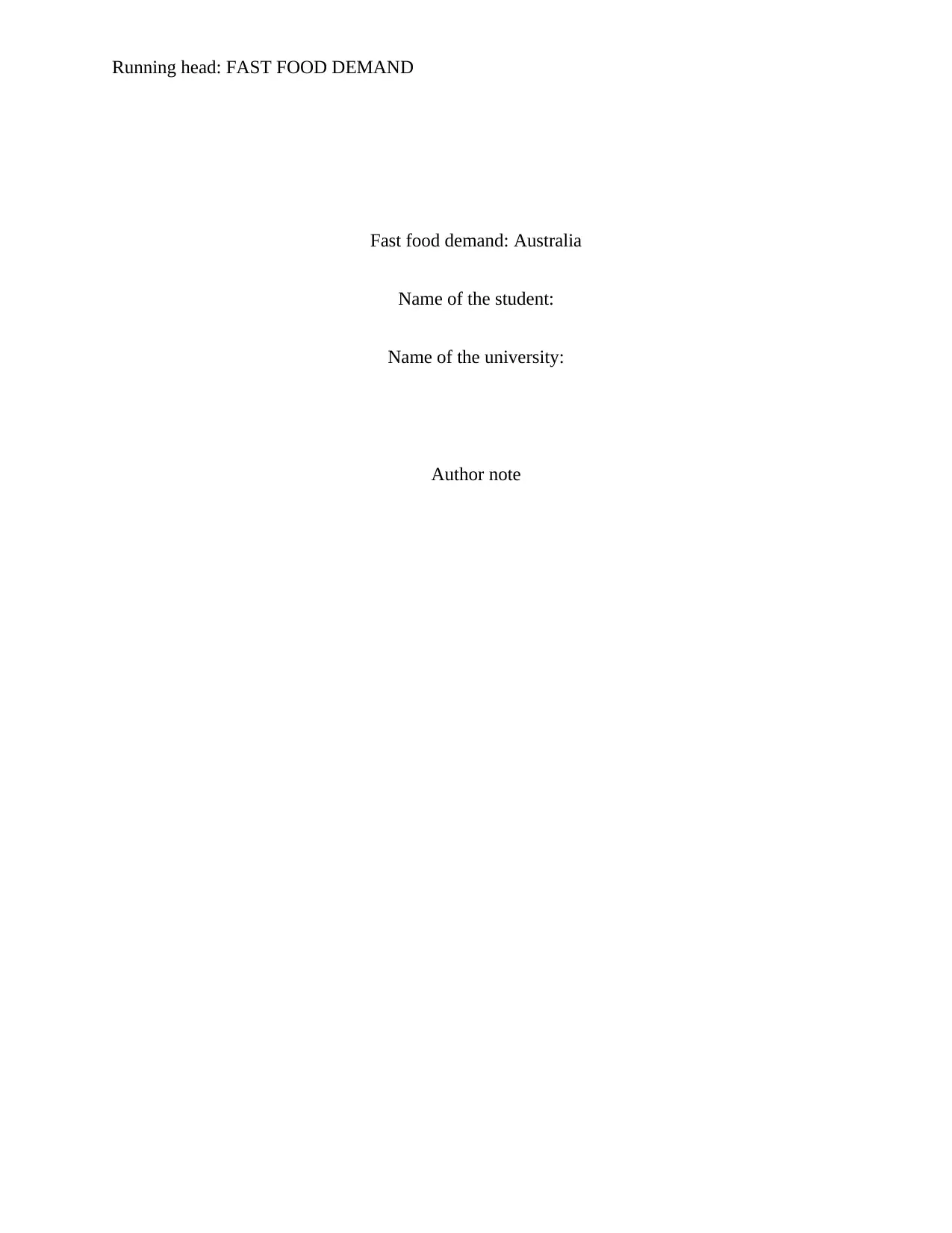
Running head: FAST FOOD DEMAND
Fast food demand: Australia
Name of the student:
Name of the university:
Author note
Fast food demand: Australia
Name of the student:
Name of the university:
Author note
Paraphrase This Document
Need a fresh take? Get an instant paraphrase of this document with our AI Paraphraser
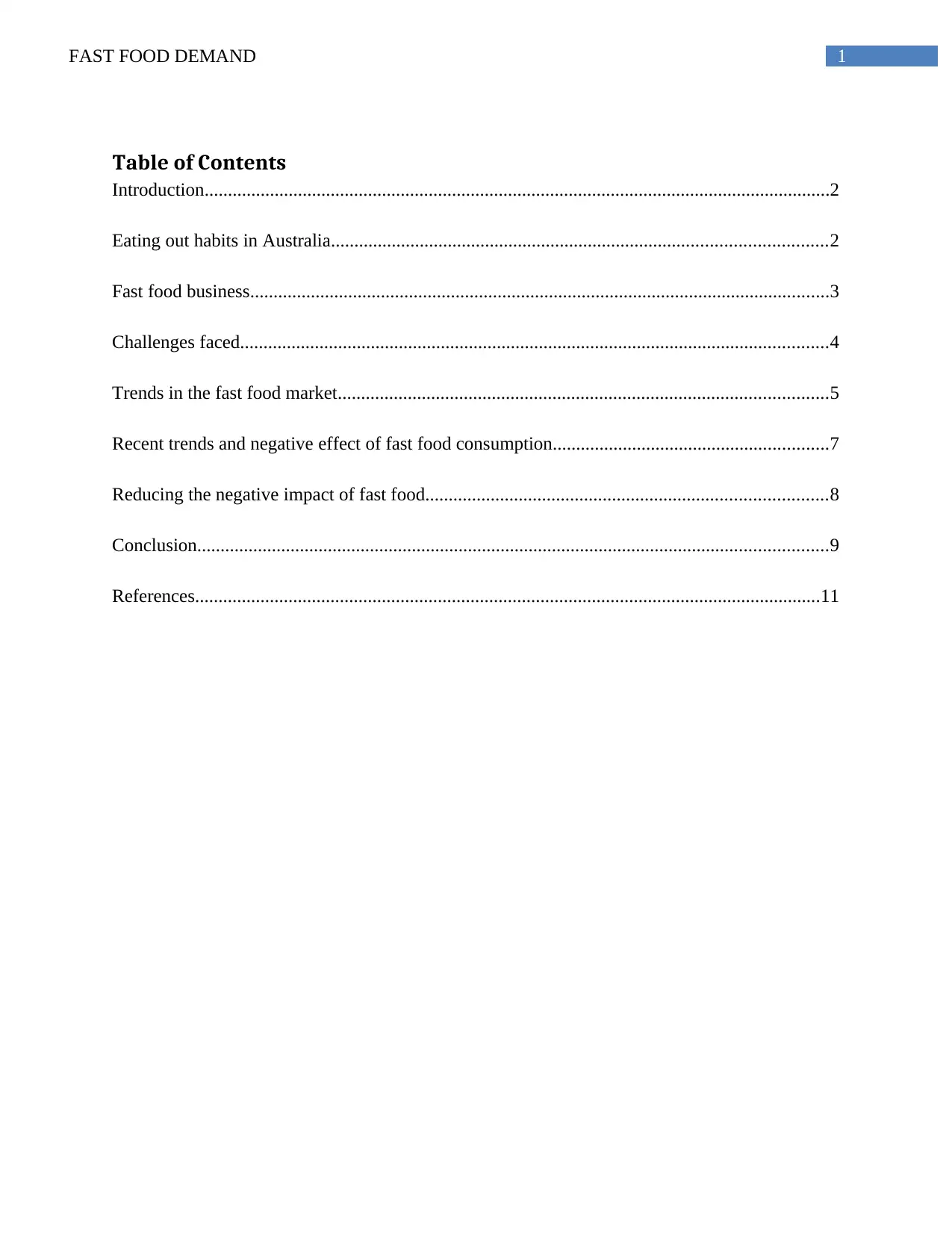
1FAST FOOD DEMAND
Table of Contents
Introduction......................................................................................................................................2
Eating out habits in Australia..........................................................................................................2
Fast food business............................................................................................................................3
Challenges faced..............................................................................................................................4
Trends in the fast food market.........................................................................................................5
Recent trends and negative effect of fast food consumption...........................................................7
Reducing the negative impact of fast food......................................................................................8
Conclusion.......................................................................................................................................9
References......................................................................................................................................11
Table of Contents
Introduction......................................................................................................................................2
Eating out habits in Australia..........................................................................................................2
Fast food business............................................................................................................................3
Challenges faced..............................................................................................................................4
Trends in the fast food market.........................................................................................................5
Recent trends and negative effect of fast food consumption...........................................................7
Reducing the negative impact of fast food......................................................................................8
Conclusion.......................................................................................................................................9
References......................................................................................................................................11
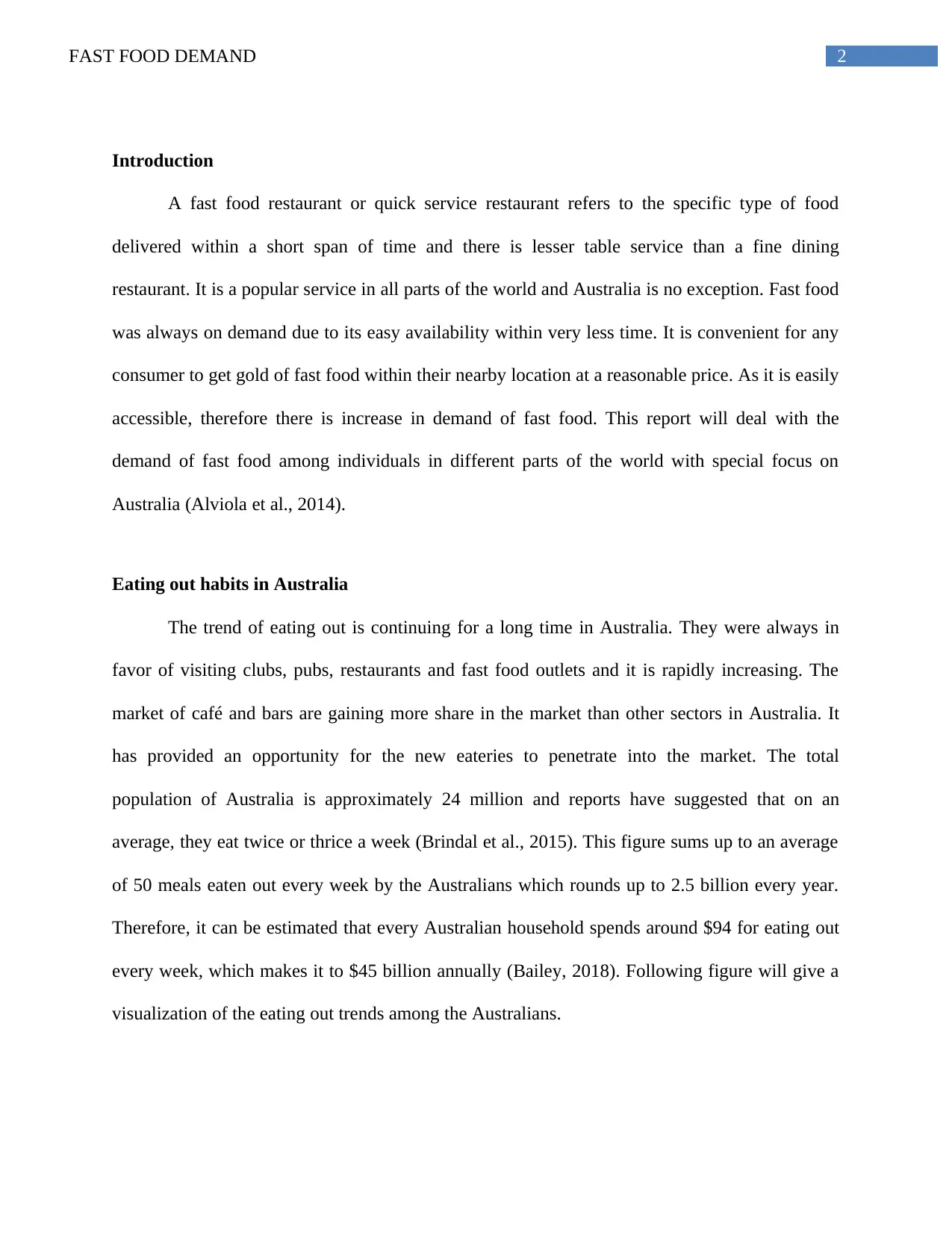
2FAST FOOD DEMAND
Introduction
A fast food restaurant or quick service restaurant refers to the specific type of food
delivered within a short span of time and there is lesser table service than a fine dining
restaurant. It is a popular service in all parts of the world and Australia is no exception. Fast food
was always on demand due to its easy availability within very less time. It is convenient for any
consumer to get gold of fast food within their nearby location at a reasonable price. As it is easily
accessible, therefore there is increase in demand of fast food. This report will deal with the
demand of fast food among individuals in different parts of the world with special focus on
Australia (Alviola et al., 2014).
Eating out habits in Australia
The trend of eating out is continuing for a long time in Australia. They were always in
favor of visiting clubs, pubs, restaurants and fast food outlets and it is rapidly increasing. The
market of café and bars are gaining more share in the market than other sectors in Australia. It
has provided an opportunity for the new eateries to penetrate into the market. The total
population of Australia is approximately 24 million and reports have suggested that on an
average, they eat twice or thrice a week (Brindal et al., 2015). This figure sums up to an average
of 50 meals eaten out every week by the Australians which rounds up to 2.5 billion every year.
Therefore, it can be estimated that every Australian household spends around $94 for eating out
every week, which makes it to $45 billion annually (Bailey, 2018). Following figure will give a
visualization of the eating out trends among the Australians.
Introduction
A fast food restaurant or quick service restaurant refers to the specific type of food
delivered within a short span of time and there is lesser table service than a fine dining
restaurant. It is a popular service in all parts of the world and Australia is no exception. Fast food
was always on demand due to its easy availability within very less time. It is convenient for any
consumer to get gold of fast food within their nearby location at a reasonable price. As it is easily
accessible, therefore there is increase in demand of fast food. This report will deal with the
demand of fast food among individuals in different parts of the world with special focus on
Australia (Alviola et al., 2014).
Eating out habits in Australia
The trend of eating out is continuing for a long time in Australia. They were always in
favor of visiting clubs, pubs, restaurants and fast food outlets and it is rapidly increasing. The
market of café and bars are gaining more share in the market than other sectors in Australia. It
has provided an opportunity for the new eateries to penetrate into the market. The total
population of Australia is approximately 24 million and reports have suggested that on an
average, they eat twice or thrice a week (Brindal et al., 2015). This figure sums up to an average
of 50 meals eaten out every week by the Australians which rounds up to 2.5 billion every year.
Therefore, it can be estimated that every Australian household spends around $94 for eating out
every week, which makes it to $45 billion annually (Bailey, 2018). Following figure will give a
visualization of the eating out trends among the Australians.
⊘ This is a preview!⊘
Do you want full access?
Subscribe today to unlock all pages.

Trusted by 1+ million students worldwide
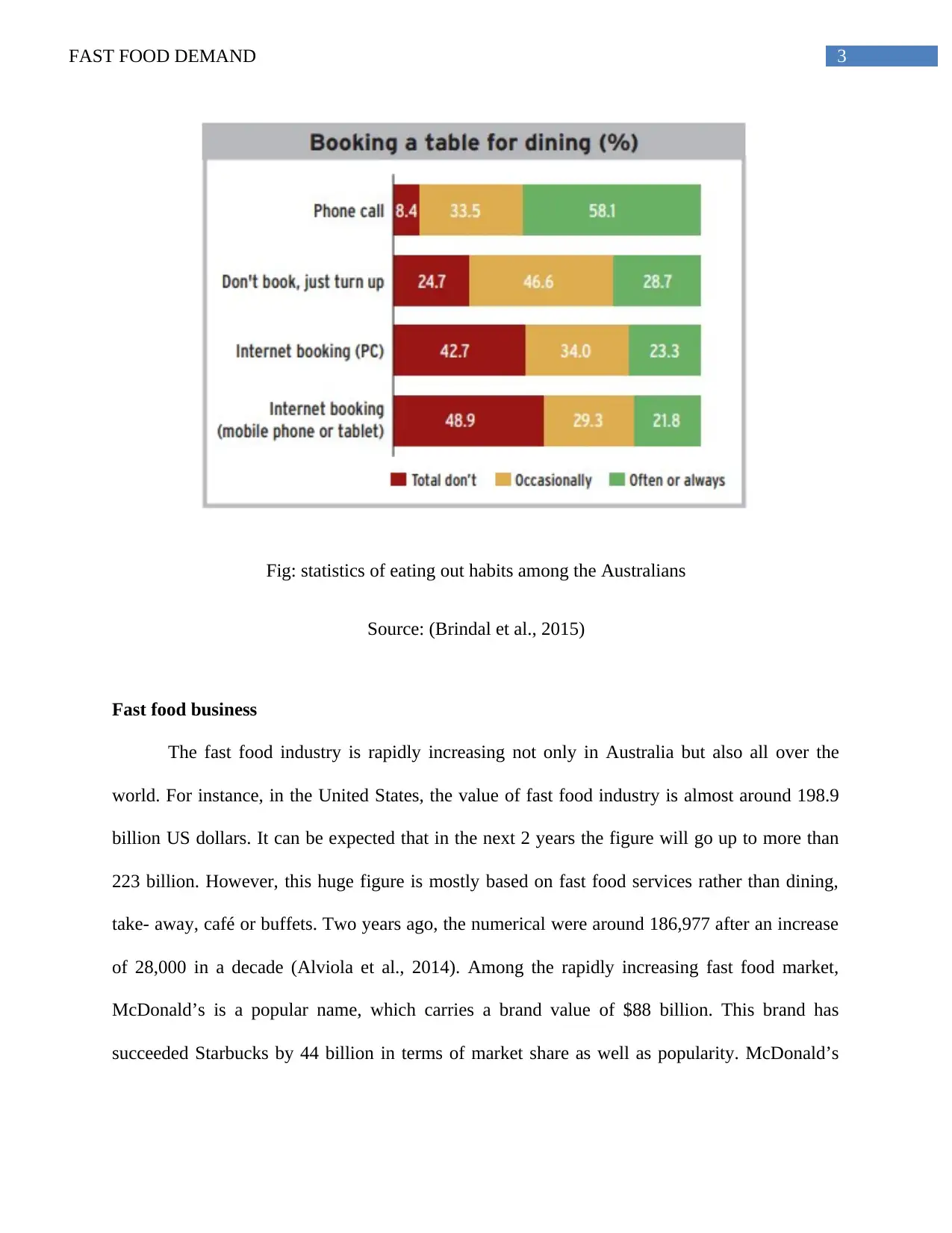
3FAST FOOD DEMAND
Fig: statistics of eating out habits among the Australians
Source: (Brindal et al., 2015)
Fast food business
The fast food industry is rapidly increasing not only in Australia but also all over the
world. For instance, in the United States, the value of fast food industry is almost around 198.9
billion US dollars. It can be expected that in the next 2 years the figure will go up to more than
223 billion. However, this huge figure is mostly based on fast food services rather than dining,
take- away, café or buffets. Two years ago, the numerical were around 186,977 after an increase
of 28,000 in a decade (Alviola et al., 2014). Among the rapidly increasing fast food market,
McDonald’s is a popular name, which carries a brand value of $88 billion. This brand has
succeeded Starbucks by 44 billion in terms of market share as well as popularity. McDonald’s
Fig: statistics of eating out habits among the Australians
Source: (Brindal et al., 2015)
Fast food business
The fast food industry is rapidly increasing not only in Australia but also all over the
world. For instance, in the United States, the value of fast food industry is almost around 198.9
billion US dollars. It can be expected that in the next 2 years the figure will go up to more than
223 billion. However, this huge figure is mostly based on fast food services rather than dining,
take- away, café or buffets. Two years ago, the numerical were around 186,977 after an increase
of 28,000 in a decade (Alviola et al., 2014). Among the rapidly increasing fast food market,
McDonald’s is a popular name, which carries a brand value of $88 billion. This brand has
succeeded Starbucks by 44 billion in terms of market share as well as popularity. McDonald’s
Paraphrase This Document
Need a fresh take? Get an instant paraphrase of this document with our AI Paraphraser
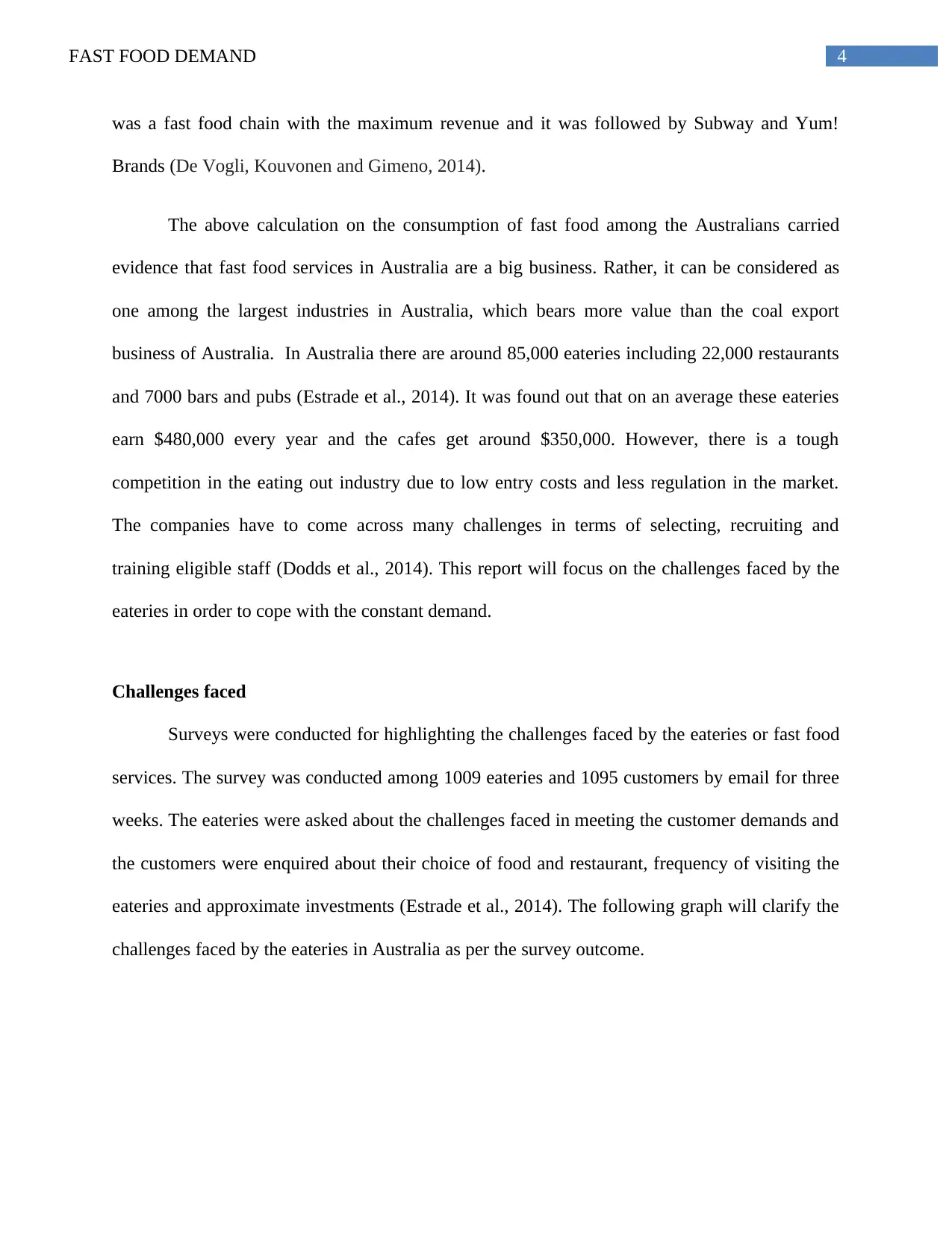
4FAST FOOD DEMAND
was a fast food chain with the maximum revenue and it was followed by Subway and Yum!
Brands (De Vogli, Kouvonen and Gimeno, 2014).
The above calculation on the consumption of fast food among the Australians carried
evidence that fast food services in Australia are a big business. Rather, it can be considered as
one among the largest industries in Australia, which bears more value than the coal export
business of Australia. In Australia there are around 85,000 eateries including 22,000 restaurants
and 7000 bars and pubs (Estrade et al., 2014). It was found out that on an average these eateries
earn $480,000 every year and the cafes get around $350,000. However, there is a tough
competition in the eating out industry due to low entry costs and less regulation in the market.
The companies have to come across many challenges in terms of selecting, recruiting and
training eligible staff (Dodds et al., 2014). This report will focus on the challenges faced by the
eateries in order to cope with the constant demand.
Challenges faced
Surveys were conducted for highlighting the challenges faced by the eateries or fast food
services. The survey was conducted among 1009 eateries and 1095 customers by email for three
weeks. The eateries were asked about the challenges faced in meeting the customer demands and
the customers were enquired about their choice of food and restaurant, frequency of visiting the
eateries and approximate investments (Estrade et al., 2014). The following graph will clarify the
challenges faced by the eateries in Australia as per the survey outcome.
was a fast food chain with the maximum revenue and it was followed by Subway and Yum!
Brands (De Vogli, Kouvonen and Gimeno, 2014).
The above calculation on the consumption of fast food among the Australians carried
evidence that fast food services in Australia are a big business. Rather, it can be considered as
one among the largest industries in Australia, which bears more value than the coal export
business of Australia. In Australia there are around 85,000 eateries including 22,000 restaurants
and 7000 bars and pubs (Estrade et al., 2014). It was found out that on an average these eateries
earn $480,000 every year and the cafes get around $350,000. However, there is a tough
competition in the eating out industry due to low entry costs and less regulation in the market.
The companies have to come across many challenges in terms of selecting, recruiting and
training eligible staff (Dodds et al., 2014). This report will focus on the challenges faced by the
eateries in order to cope with the constant demand.
Challenges faced
Surveys were conducted for highlighting the challenges faced by the eateries or fast food
services. The survey was conducted among 1009 eateries and 1095 customers by email for three
weeks. The eateries were asked about the challenges faced in meeting the customer demands and
the customers were enquired about their choice of food and restaurant, frequency of visiting the
eateries and approximate investments (Estrade et al., 2014). The following graph will clarify the
challenges faced by the eateries in Australia as per the survey outcome.
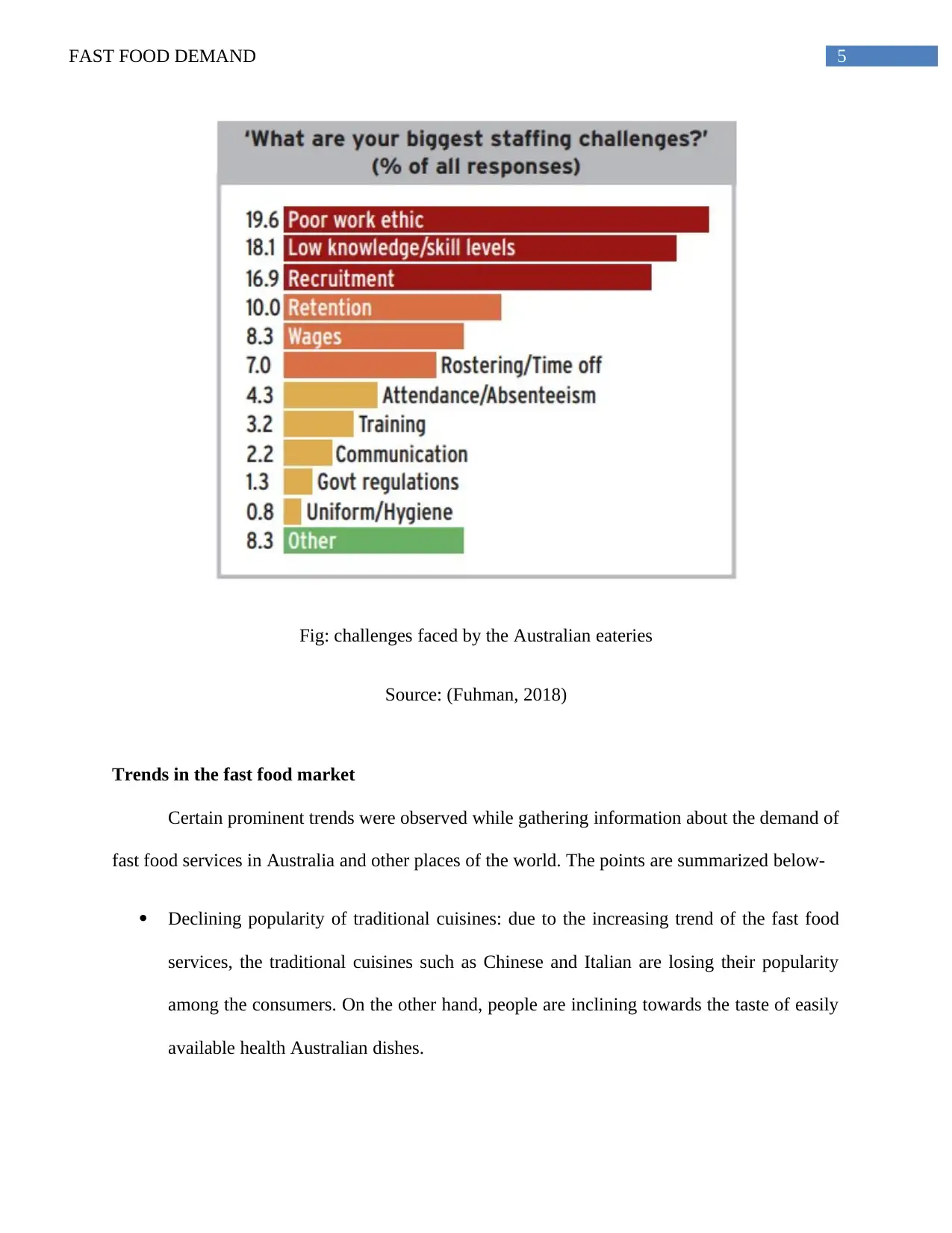
5FAST FOOD DEMAND
Fig: challenges faced by the Australian eateries
Source: (Fuhman, 2018)
Trends in the fast food market
Certain prominent trends were observed while gathering information about the demand of
fast food services in Australia and other places of the world. The points are summarized below-
Declining popularity of traditional cuisines: due to the increasing trend of the fast food
services, the traditional cuisines such as Chinese and Italian are losing their popularity
among the consumers. On the other hand, people are inclining towards the taste of easily
available health Australian dishes.
Fig: challenges faced by the Australian eateries
Source: (Fuhman, 2018)
Trends in the fast food market
Certain prominent trends were observed while gathering information about the demand of
fast food services in Australia and other places of the world. The points are summarized below-
Declining popularity of traditional cuisines: due to the increasing trend of the fast food
services, the traditional cuisines such as Chinese and Italian are losing their popularity
among the consumers. On the other hand, people are inclining towards the taste of easily
available health Australian dishes.
⊘ This is a preview!⊘
Do you want full access?
Subscribe today to unlock all pages.

Trusted by 1+ million students worldwide
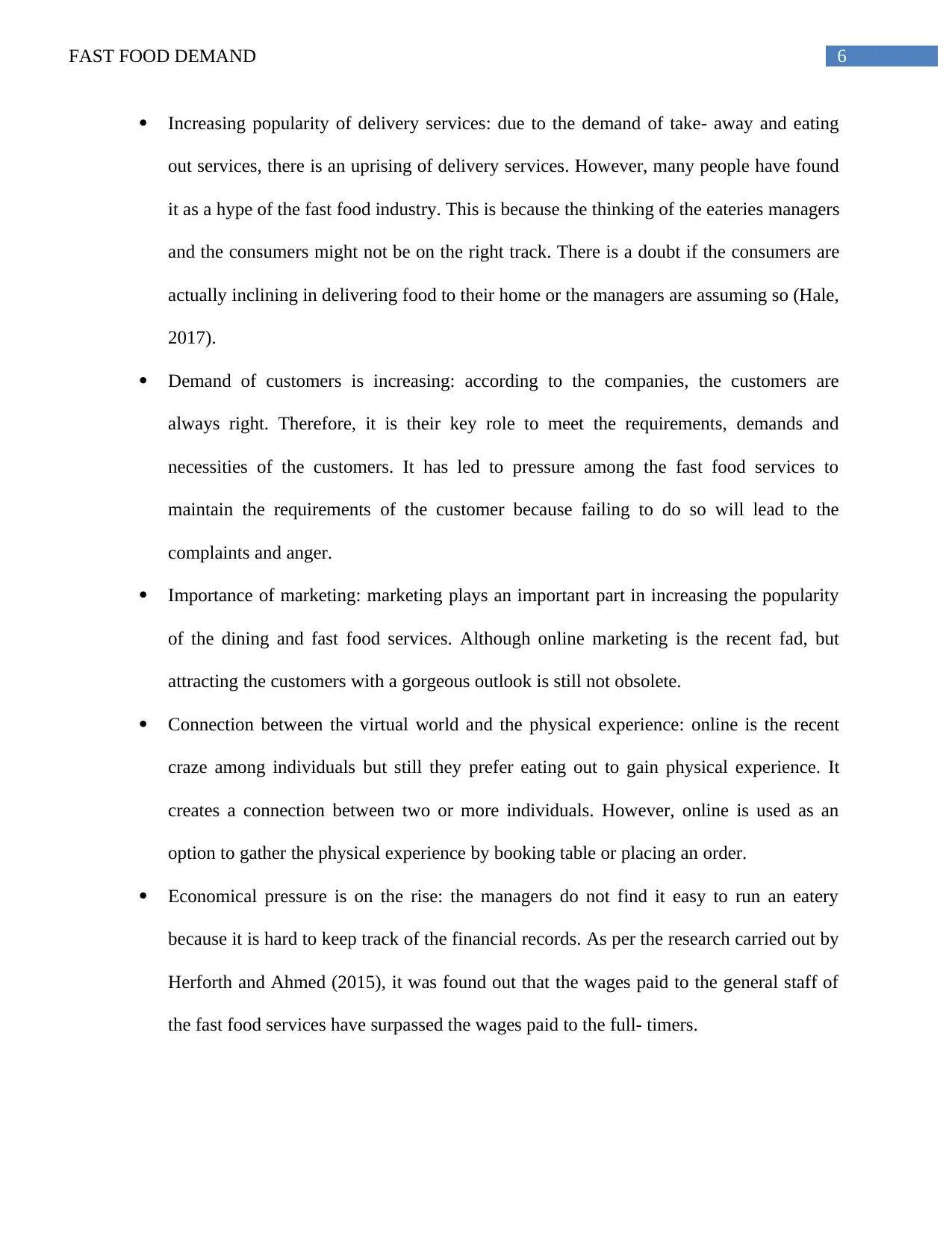
6FAST FOOD DEMAND
Increasing popularity of delivery services: due to the demand of take- away and eating
out services, there is an uprising of delivery services. However, many people have found
it as a hype of the fast food industry. This is because the thinking of the eateries managers
and the consumers might not be on the right track. There is a doubt if the consumers are
actually inclining in delivering food to their home or the managers are assuming so (Hale,
2017).
Demand of customers is increasing: according to the companies, the customers are
always right. Therefore, it is their key role to meet the requirements, demands and
necessities of the customers. It has led to pressure among the fast food services to
maintain the requirements of the customer because failing to do so will lead to the
complaints and anger.
Importance of marketing: marketing plays an important part in increasing the popularity
of the dining and fast food services. Although online marketing is the recent fad, but
attracting the customers with a gorgeous outlook is still not obsolete.
Connection between the virtual world and the physical experience: online is the recent
craze among individuals but still they prefer eating out to gain physical experience. It
creates a connection between two or more individuals. However, online is used as an
option to gather the physical experience by booking table or placing an order.
Economical pressure is on the rise: the managers do not find it easy to run an eatery
because it is hard to keep track of the financial records. As per the research carried out by
Herforth and Ahmed (2015), it was found out that the wages paid to the general staff of
the fast food services have surpassed the wages paid to the full- timers.
Increasing popularity of delivery services: due to the demand of take- away and eating
out services, there is an uprising of delivery services. However, many people have found
it as a hype of the fast food industry. This is because the thinking of the eateries managers
and the consumers might not be on the right track. There is a doubt if the consumers are
actually inclining in delivering food to their home or the managers are assuming so (Hale,
2017).
Demand of customers is increasing: according to the companies, the customers are
always right. Therefore, it is their key role to meet the requirements, demands and
necessities of the customers. It has led to pressure among the fast food services to
maintain the requirements of the customer because failing to do so will lead to the
complaints and anger.
Importance of marketing: marketing plays an important part in increasing the popularity
of the dining and fast food services. Although online marketing is the recent fad, but
attracting the customers with a gorgeous outlook is still not obsolete.
Connection between the virtual world and the physical experience: online is the recent
craze among individuals but still they prefer eating out to gain physical experience. It
creates a connection between two or more individuals. However, online is used as an
option to gather the physical experience by booking table or placing an order.
Economical pressure is on the rise: the managers do not find it easy to run an eatery
because it is hard to keep track of the financial records. As per the research carried out by
Herforth and Ahmed (2015), it was found out that the wages paid to the general staff of
the fast food services have surpassed the wages paid to the full- timers.
Paraphrase This Document
Need a fresh take? Get an instant paraphrase of this document with our AI Paraphraser
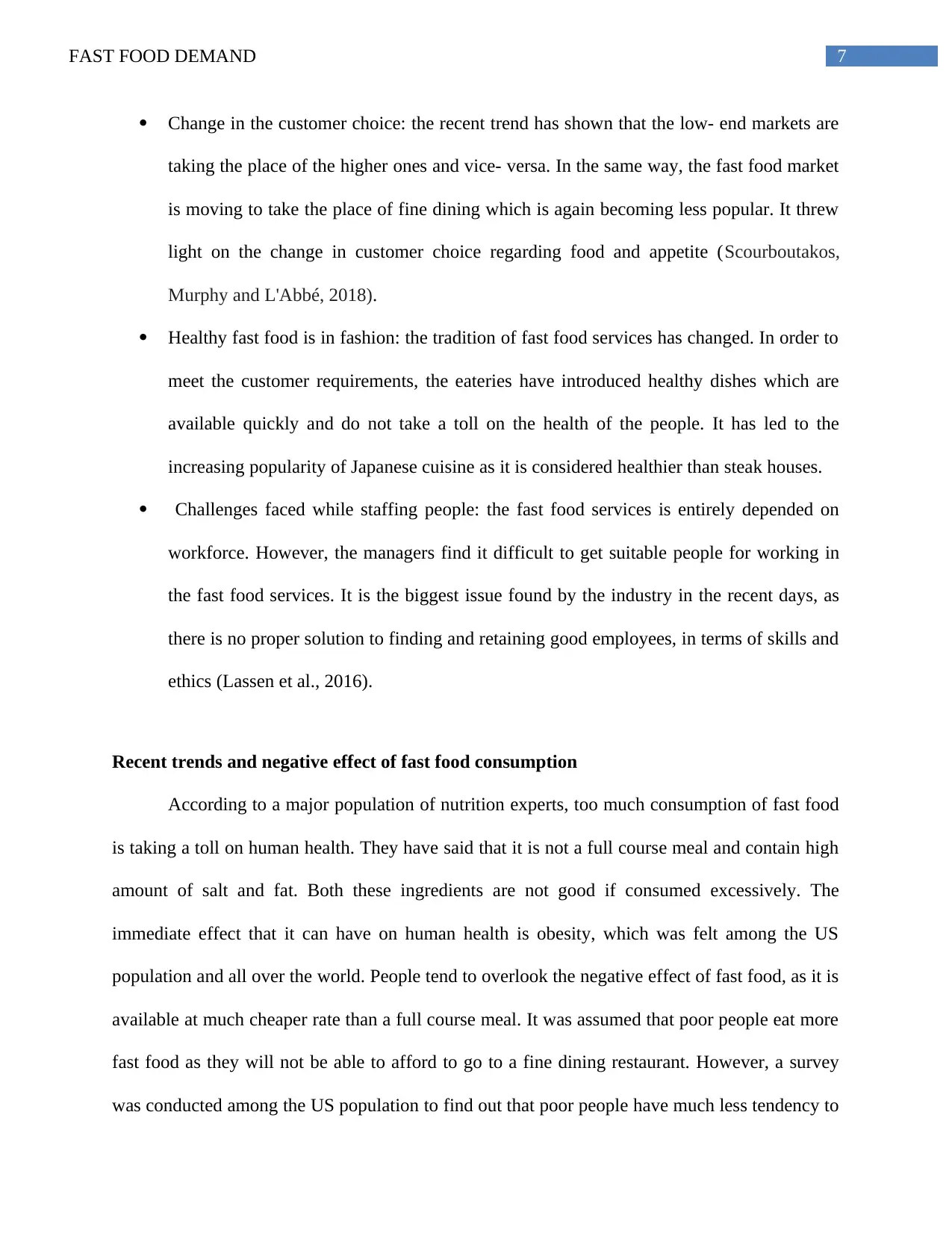
7FAST FOOD DEMAND
Change in the customer choice: the recent trend has shown that the low- end markets are
taking the place of the higher ones and vice- versa. In the same way, the fast food market
is moving to take the place of fine dining which is again becoming less popular. It threw
light on the change in customer choice regarding food and appetite (Scourboutakos,
Murphy and L'Abbé, 2018).
Healthy fast food is in fashion: the tradition of fast food services has changed. In order to
meet the customer requirements, the eateries have introduced healthy dishes which are
available quickly and do not take a toll on the health of the people. It has led to the
increasing popularity of Japanese cuisine as it is considered healthier than steak houses.
Challenges faced while staffing people: the fast food services is entirely depended on
workforce. However, the managers find it difficult to get suitable people for working in
the fast food services. It is the biggest issue found by the industry in the recent days, as
there is no proper solution to finding and retaining good employees, in terms of skills and
ethics (Lassen et al., 2016).
Recent trends and negative effect of fast food consumption
According to a major population of nutrition experts, too much consumption of fast food
is taking a toll on human health. They have said that it is not a full course meal and contain high
amount of salt and fat. Both these ingredients are not good if consumed excessively. The
immediate effect that it can have on human health is obesity, which was felt among the US
population and all over the world. People tend to overlook the negative effect of fast food, as it is
available at much cheaper rate than a full course meal. It was assumed that poor people eat more
fast food as they will not be able to afford to go to a fine dining restaurant. However, a survey
was conducted among the US population to find out that poor people have much less tendency to
Change in the customer choice: the recent trend has shown that the low- end markets are
taking the place of the higher ones and vice- versa. In the same way, the fast food market
is moving to take the place of fine dining which is again becoming less popular. It threw
light on the change in customer choice regarding food and appetite (Scourboutakos,
Murphy and L'Abbé, 2018).
Healthy fast food is in fashion: the tradition of fast food services has changed. In order to
meet the customer requirements, the eateries have introduced healthy dishes which are
available quickly and do not take a toll on the health of the people. It has led to the
increasing popularity of Japanese cuisine as it is considered healthier than steak houses.
Challenges faced while staffing people: the fast food services is entirely depended on
workforce. However, the managers find it difficult to get suitable people for working in
the fast food services. It is the biggest issue found by the industry in the recent days, as
there is no proper solution to finding and retaining good employees, in terms of skills and
ethics (Lassen et al., 2016).
Recent trends and negative effect of fast food consumption
According to a major population of nutrition experts, too much consumption of fast food
is taking a toll on human health. They have said that it is not a full course meal and contain high
amount of salt and fat. Both these ingredients are not good if consumed excessively. The
immediate effect that it can have on human health is obesity, which was felt among the US
population and all over the world. People tend to overlook the negative effect of fast food, as it is
available at much cheaper rate than a full course meal. It was assumed that poor people eat more
fast food as they will not be able to afford to go to a fine dining restaurant. However, a survey
was conducted among the US population to find out that poor people have much less tendency to
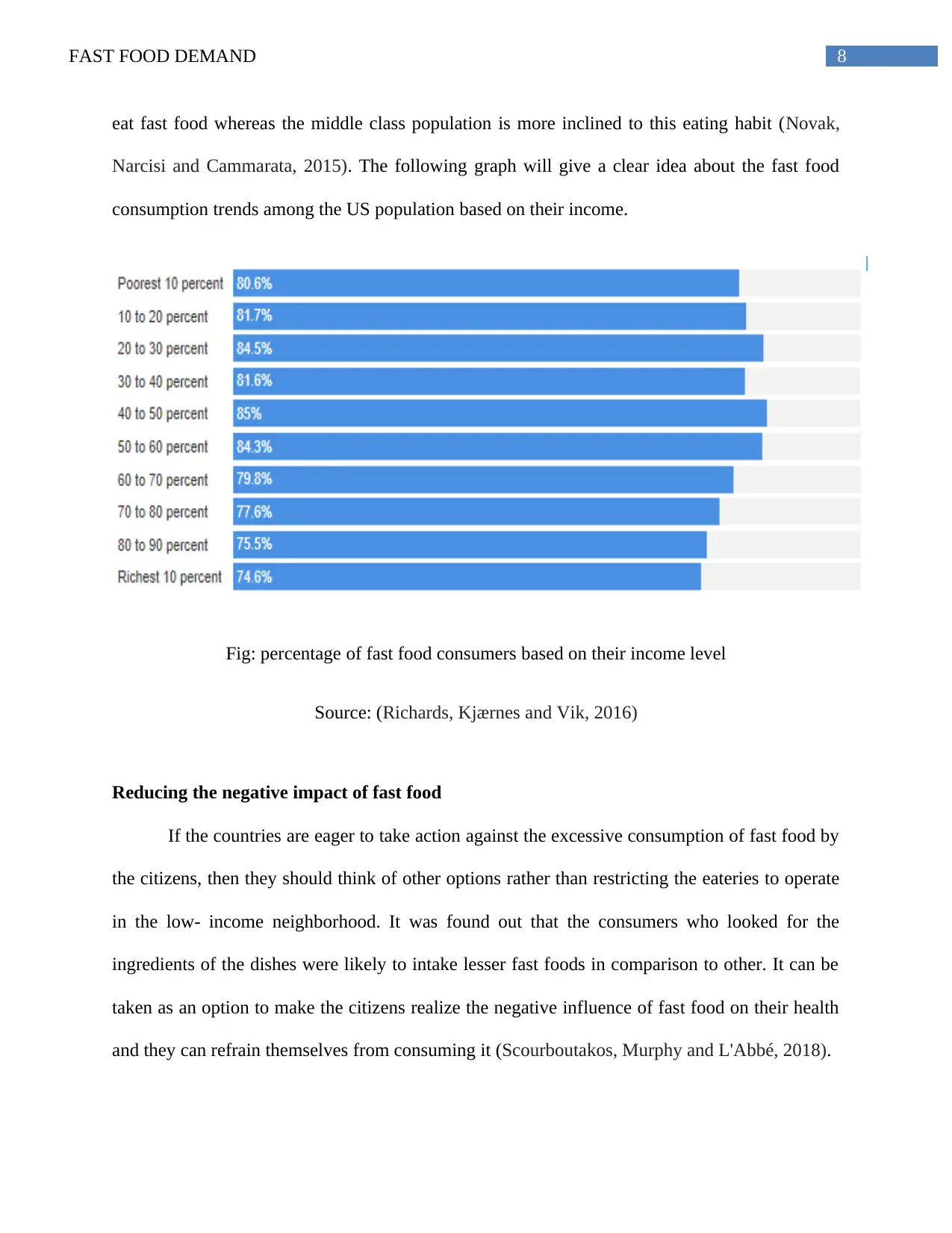
8FAST FOOD DEMAND
eat fast food whereas the middle class population is more inclined to this eating habit (Novak,
Narcisi and Cammarata, 2015). The following graph will give a clear idea about the fast food
consumption trends among the US population based on their income.
Fig: percentage of fast food consumers based on their income level
Source: (Richards, Kjærnes and Vik, 2016)
Reducing the negative impact of fast food
If the countries are eager to take action against the excessive consumption of fast food by
the citizens, then they should think of other options rather than restricting the eateries to operate
in the low- income neighborhood. It was found out that the consumers who looked for the
ingredients of the dishes were likely to intake lesser fast foods in comparison to other. It can be
taken as an option to make the citizens realize the negative influence of fast food on their health
and they can refrain themselves from consuming it (Scourboutakos, Murphy and L'Abbé, 2018).
eat fast food whereas the middle class population is more inclined to this eating habit (Novak,
Narcisi and Cammarata, 2015). The following graph will give a clear idea about the fast food
consumption trends among the US population based on their income.
Fig: percentage of fast food consumers based on their income level
Source: (Richards, Kjærnes and Vik, 2016)
Reducing the negative impact of fast food
If the countries are eager to take action against the excessive consumption of fast food by
the citizens, then they should think of other options rather than restricting the eateries to operate
in the low- income neighborhood. It was found out that the consumers who looked for the
ingredients of the dishes were likely to intake lesser fast foods in comparison to other. It can be
taken as an option to make the citizens realize the negative influence of fast food on their health
and they can refrain themselves from consuming it (Scourboutakos, Murphy and L'Abbé, 2018).
⊘ This is a preview!⊘
Do you want full access?
Subscribe today to unlock all pages.

Trusted by 1+ million students worldwide
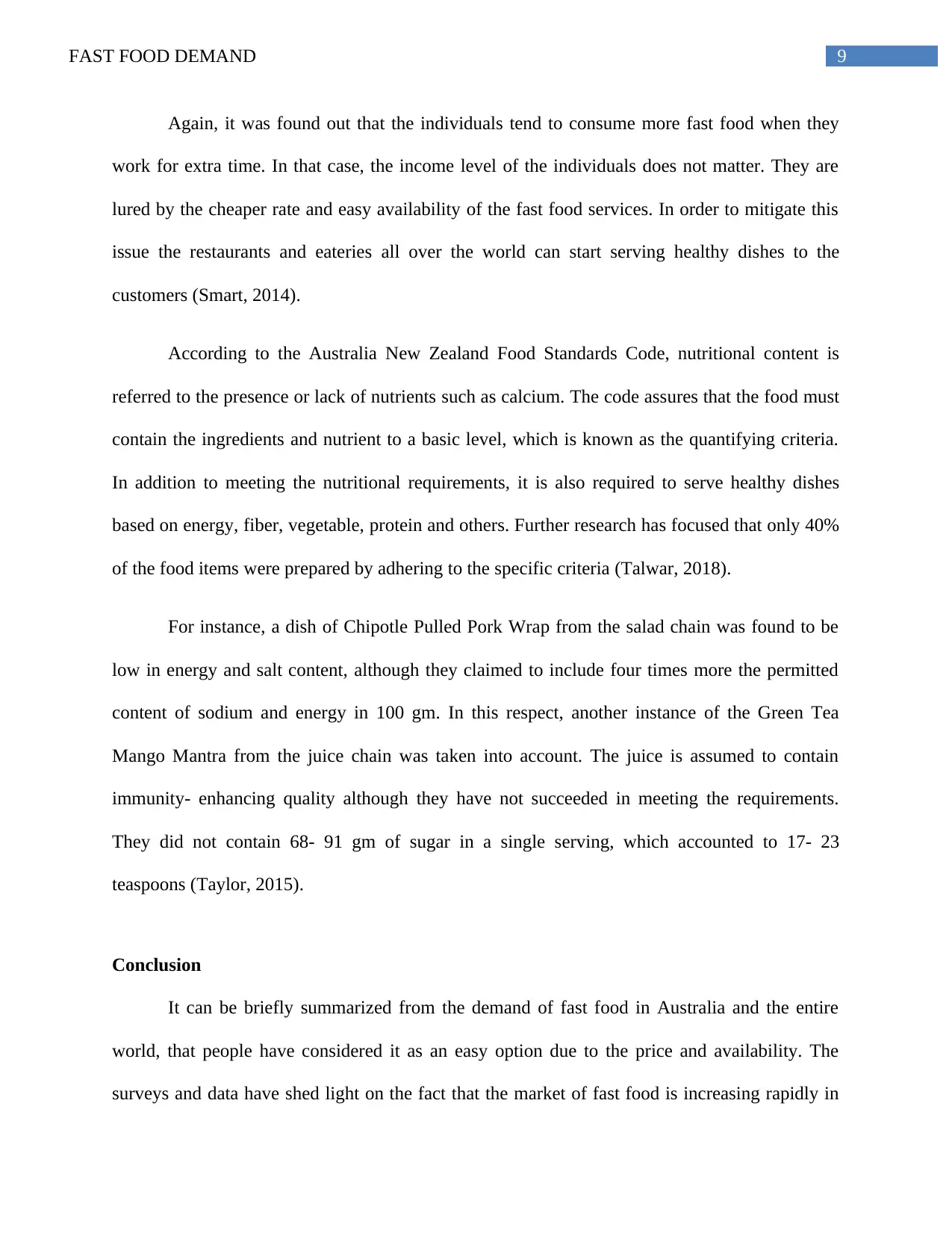
9FAST FOOD DEMAND
Again, it was found out that the individuals tend to consume more fast food when they
work for extra time. In that case, the income level of the individuals does not matter. They are
lured by the cheaper rate and easy availability of the fast food services. In order to mitigate this
issue the restaurants and eateries all over the world can start serving healthy dishes to the
customers (Smart, 2014).
According to the Australia New Zealand Food Standards Code, nutritional content is
referred to the presence or lack of nutrients such as calcium. The code assures that the food must
contain the ingredients and nutrient to a basic level, which is known as the quantifying criteria.
In addition to meeting the nutritional requirements, it is also required to serve healthy dishes
based on energy, fiber, vegetable, protein and others. Further research has focused that only 40%
of the food items were prepared by adhering to the specific criteria (Talwar, 2018).
For instance, a dish of Chipotle Pulled Pork Wrap from the salad chain was found to be
low in energy and salt content, although they claimed to include four times more the permitted
content of sodium and energy in 100 gm. In this respect, another instance of the Green Tea
Mango Mantra from the juice chain was taken into account. The juice is assumed to contain
immunity- enhancing quality although they have not succeeded in meeting the requirements.
They did not contain 68- 91 gm of sugar in a single serving, which accounted to 17- 23
teaspoons (Taylor, 2015).
Conclusion
It can be briefly summarized from the demand of fast food in Australia and the entire
world, that people have considered it as an easy option due to the price and availability. The
surveys and data have shed light on the fact that the market of fast food is increasing rapidly in
Again, it was found out that the individuals tend to consume more fast food when they
work for extra time. In that case, the income level of the individuals does not matter. They are
lured by the cheaper rate and easy availability of the fast food services. In order to mitigate this
issue the restaurants and eateries all over the world can start serving healthy dishes to the
customers (Smart, 2014).
According to the Australia New Zealand Food Standards Code, nutritional content is
referred to the presence or lack of nutrients such as calcium. The code assures that the food must
contain the ingredients and nutrient to a basic level, which is known as the quantifying criteria.
In addition to meeting the nutritional requirements, it is also required to serve healthy dishes
based on energy, fiber, vegetable, protein and others. Further research has focused that only 40%
of the food items were prepared by adhering to the specific criteria (Talwar, 2018).
For instance, a dish of Chipotle Pulled Pork Wrap from the salad chain was found to be
low in energy and salt content, although they claimed to include four times more the permitted
content of sodium and energy in 100 gm. In this respect, another instance of the Green Tea
Mango Mantra from the juice chain was taken into account. The juice is assumed to contain
immunity- enhancing quality although they have not succeeded in meeting the requirements.
They did not contain 68- 91 gm of sugar in a single serving, which accounted to 17- 23
teaspoons (Taylor, 2015).
Conclusion
It can be briefly summarized from the demand of fast food in Australia and the entire
world, that people have considered it as an easy option due to the price and availability. The
surveys and data have shed light on the fact that the market of fast food is increasing rapidly in
Paraphrase This Document
Need a fresh take? Get an instant paraphrase of this document with our AI Paraphraser
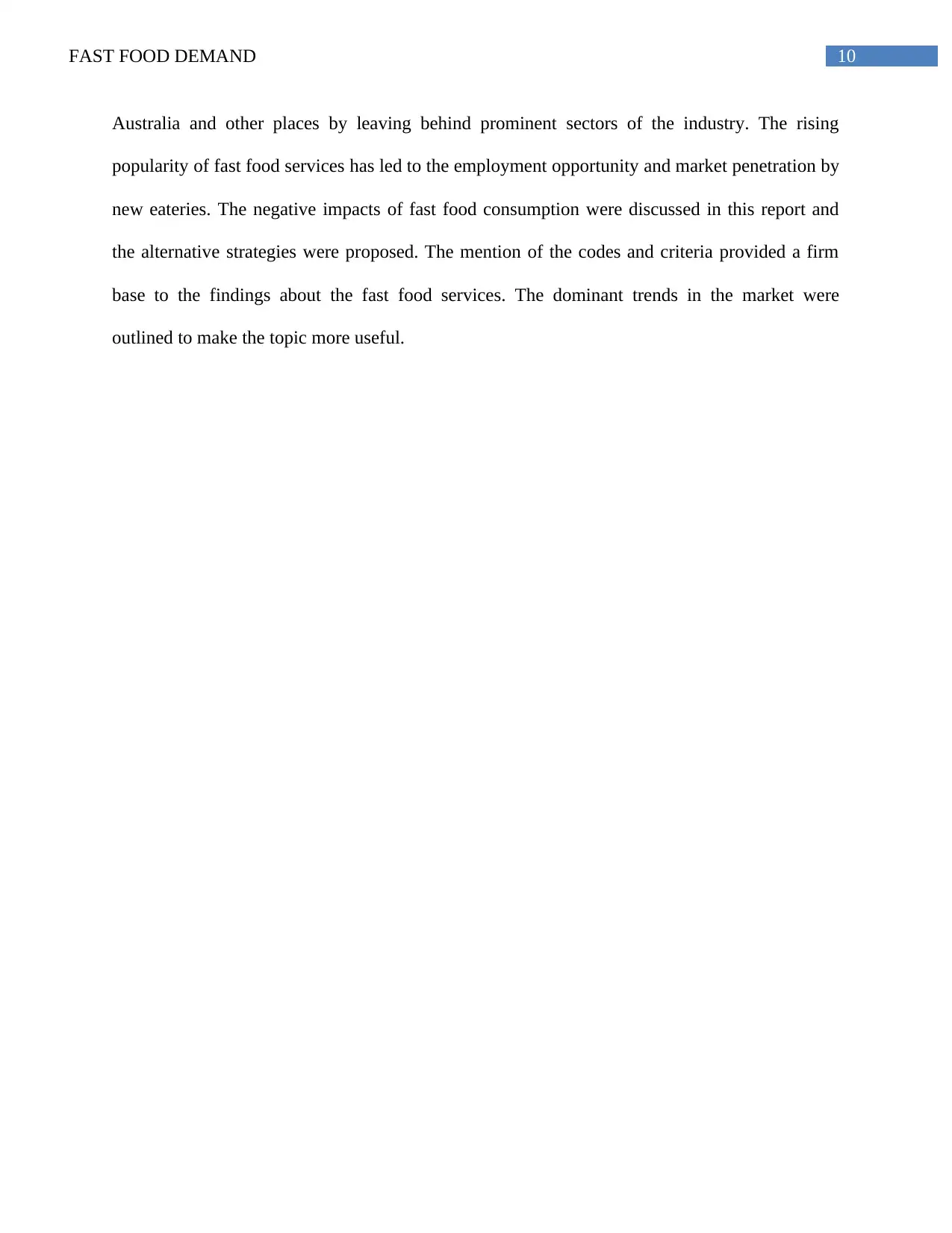
10FAST FOOD DEMAND
Australia and other places by leaving behind prominent sectors of the industry. The rising
popularity of fast food services has led to the employment opportunity and market penetration by
new eateries. The negative impacts of fast food consumption were discussed in this report and
the alternative strategies were proposed. The mention of the codes and criteria provided a firm
base to the findings about the fast food services. The dominant trends in the market were
outlined to make the topic more useful.
Australia and other places by leaving behind prominent sectors of the industry. The rising
popularity of fast food services has led to the employment opportunity and market penetration by
new eateries. The negative impacts of fast food consumption were discussed in this report and
the alternative strategies were proposed. The mention of the codes and criteria provided a firm
base to the findings about the fast food services. The dominant trends in the market were
outlined to make the topic more useful.
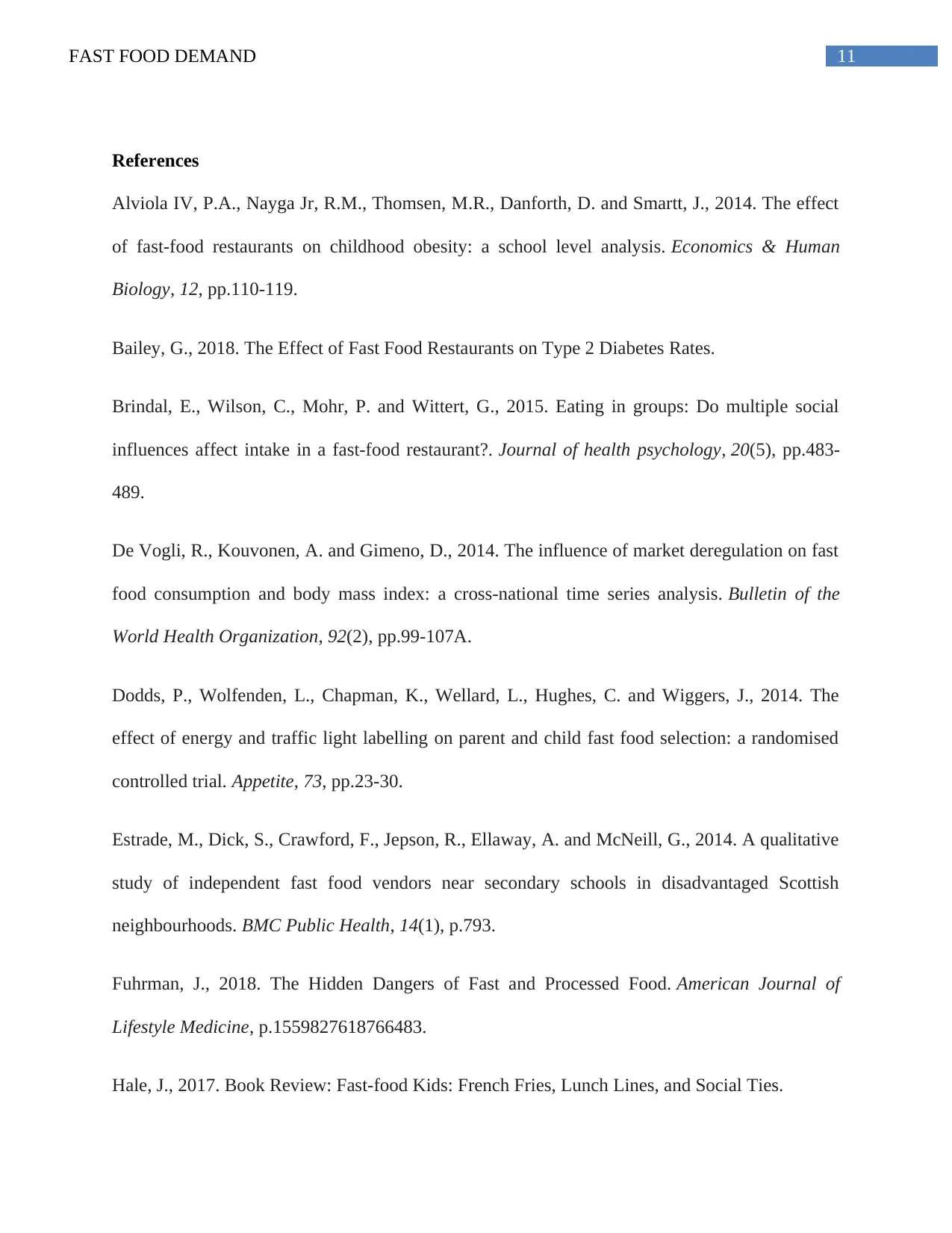
11FAST FOOD DEMAND
References
Alviola IV, P.A., Nayga Jr, R.M., Thomsen, M.R., Danforth, D. and Smartt, J., 2014. The effect
of fast-food restaurants on childhood obesity: a school level analysis. Economics & Human
Biology, 12, pp.110-119.
Bailey, G., 2018. The Effect of Fast Food Restaurants on Type 2 Diabetes Rates.
Brindal, E., Wilson, C., Mohr, P. and Wittert, G., 2015. Eating in groups: Do multiple social
influences affect intake in a fast-food restaurant?. Journal of health psychology, 20(5), pp.483-
489.
De Vogli, R., Kouvonen, A. and Gimeno, D., 2014. The influence of market deregulation on fast
food consumption and body mass index: a cross-national time series analysis. Bulletin of the
World Health Organization, 92(2), pp.99-107A.
Dodds, P., Wolfenden, L., Chapman, K., Wellard, L., Hughes, C. and Wiggers, J., 2014. The
effect of energy and traffic light labelling on parent and child fast food selection: a randomised
controlled trial. Appetite, 73, pp.23-30.
Estrade, M., Dick, S., Crawford, F., Jepson, R., Ellaway, A. and McNeill, G., 2014. A qualitative
study of independent fast food vendors near secondary schools in disadvantaged Scottish
neighbourhoods. BMC Public Health, 14(1), p.793.
Fuhrman, J., 2018. The Hidden Dangers of Fast and Processed Food. American Journal of
Lifestyle Medicine, p.1559827618766483.
Hale, J., 2017. Book Review: Fast-food Kids: French Fries, Lunch Lines, and Social Ties.
References
Alviola IV, P.A., Nayga Jr, R.M., Thomsen, M.R., Danforth, D. and Smartt, J., 2014. The effect
of fast-food restaurants on childhood obesity: a school level analysis. Economics & Human
Biology, 12, pp.110-119.
Bailey, G., 2018. The Effect of Fast Food Restaurants on Type 2 Diabetes Rates.
Brindal, E., Wilson, C., Mohr, P. and Wittert, G., 2015. Eating in groups: Do multiple social
influences affect intake in a fast-food restaurant?. Journal of health psychology, 20(5), pp.483-
489.
De Vogli, R., Kouvonen, A. and Gimeno, D., 2014. The influence of market deregulation on fast
food consumption and body mass index: a cross-national time series analysis. Bulletin of the
World Health Organization, 92(2), pp.99-107A.
Dodds, P., Wolfenden, L., Chapman, K., Wellard, L., Hughes, C. and Wiggers, J., 2014. The
effect of energy and traffic light labelling on parent and child fast food selection: a randomised
controlled trial. Appetite, 73, pp.23-30.
Estrade, M., Dick, S., Crawford, F., Jepson, R., Ellaway, A. and McNeill, G., 2014. A qualitative
study of independent fast food vendors near secondary schools in disadvantaged Scottish
neighbourhoods. BMC Public Health, 14(1), p.793.
Fuhrman, J., 2018. The Hidden Dangers of Fast and Processed Food. American Journal of
Lifestyle Medicine, p.1559827618766483.
Hale, J., 2017. Book Review: Fast-food Kids: French Fries, Lunch Lines, and Social Ties.
⊘ This is a preview!⊘
Do you want full access?
Subscribe today to unlock all pages.

Trusted by 1+ million students worldwide
1 out of 14
Related Documents
Your All-in-One AI-Powered Toolkit for Academic Success.
+13062052269
info@desklib.com
Available 24*7 on WhatsApp / Email
![[object Object]](/_next/static/media/star-bottom.7253800d.svg)
Unlock your academic potential
Copyright © 2020–2025 A2Z Services. All Rights Reserved. Developed and managed by ZUCOL.





